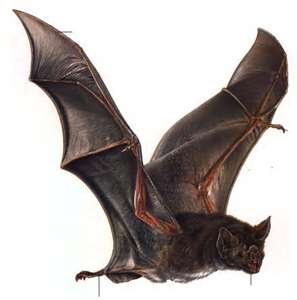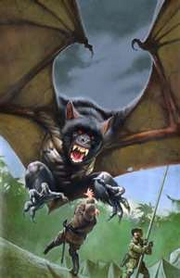|
This article, Desmodus Draculae, was written by Mr.Secord. Please do not edit this fiction without the writer's permission. |

| |
| Desmodus Draculae | |
|---|---|
| Created | Unknown |
| Created By | Pleistocene Period/Enlarging of Vampire Bats |
| Creation | Stage 1 |
| Based | Prehistoric Vampire Bat |
| Height/Length | 810cm |
| Purpose | Test Subjects |
| Status | Alive |
Desmodus Draculae is an extinct species of Vampire Bat that existed from 2,588,000 to 11,700 years ago (During the Pleistocene). It is 30% larger than it's descendent (Desmodus Rotundus). During 360 B.C., Atlantis was known to have possessed technology to clone the DNA of these bats and used them for science. They were kept in a large aviary of under the city and when the city sunk, the aviary remained intact.
2037[]
By 2037, after Atlantis rose from it's watery resting place, Kleeya Simmons and Victoria Simmons explored the city and encountered several of these bats and killed off only 3, making the others retreat to a cave. Sooner or later, Oswell E. Spencer managed to arrive on the island and captured one of these bats, starting to experimenting with many of the viruses he possessed and in turn, creating a more deadly version of the bat.
Stage 2 Desmodus Draculae[]

Stage 2 Desmodus Draculae
The Stage 2 version of this species is known to have been enhanced in size with the T-Virus and other contagions the Umbrella Corporation had at it's disposal. The bat is far more dangerous in it's second stage, not only are they larger, but some can stand on the ground and all possess superhuman strength. Usually these ones are also known to be immune to bullets, however weapons like the RPG-7 or the X-500 Plasma Cannon are known to have an extreme effect on these kind of bats. Their fangs are also larger, making them more likely to suck the blood out of their prey rather than lapping it out of the body. They are known to feed on cattle, horses, Tyrannosaurus Rex, Spinosaurus and even human beings. They are known to be the prey of the Megalodon which is actually resistant to the T-Virus infecting their bodies, thanks to an anti-body that was injected into the body in 360 B.C.